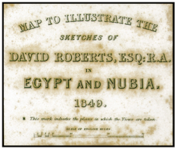VIEW UNDER THE GRAND PORTICO, PHILÆ
THIS sketch presents, in another direction, a more striking view of the exquisite sculpture and carved decorations of the columns and the painted ceilings in this beautiful portico. At the extremity of the vista, the ruins of an altar shew that it was once a place of Christian worship. It has been fractured and displaced, probably in search of treasure, for even the flooring has been broken up and disturbed. The emblem of the cross is everywhere seen, but no community of Christians now exists in the valley of the Nile from Esné to the borders of Abyssinia.
Many objects of great interest are found by those who search for them amidst the ruins of this Temple, but some that are in dark chambers are of more historical than picturesque importance. All these structures, however, are of comparatively low date - the oldest not more than 380 years B.C. The Ptolemies raised this beautiful Temple upon what remained of the structures built by Nectanebo, and which was destroyed by the Persians in their last invasion of Egypt; and they continued to enrich and adorn this shrine, even to the last of them - “the Serpent of Old Nile,” whose portrait is appropriately sculptured on the walls of this Temple, dedicated to Athor. Other portraits also are here of Ptolemaic Queens, but not only is that of Cleopatra more strikingly handsome than either those of Arsinoë or Berenice, but her eventful history commands a higher interest in a resemblance which, it is highly probable, is authentic.
Nor did the interest in Philæ cease with the Ptolemies. The Roman Emperors successively enriched it, and so great was the celebrity of this Temple, that numerous Greek and Latin inscriptions attest the feelings, with the names, of many who came to worship in the Temple of Isis: these made such heavy claims upon the funds of the priests, that a Greek inscription exists on the pedestal of the Obelisk which Belzoni removed from Philæ, in which they appeal to Ptolemy Physcon, who was a great benefactor to their Temple, to prevent so many persons of rank and public functionaries from visiting the island, and living at their expense. It is as follows: -
“To King Ptolemy, and Queen Cleopatra his sister, and the Queen Cleopatra his wife, gods Euergetes welfare: We the priests of Isis, the very great goddess [worshipped] in Abaton and Philæ; seeing that those who visit Philæ, generals, chiefs, governors of districts in the Thebaïd, royal scribes, chiefs of police, and all other functionaries, as well as their soldiers and other attendants, oblige us to provide for them during their stay; the consequence of which is, that the temple is impoverished, and we run the risk of not having enough for the customary sacrifices and libations offered for you and your children; do therefore pray you, O great gods, if it seem right to you, to order Numenius, your cousin and secretary, to write Lochus, your cousin and governor of the Thebaïd, not to disturb us in this manner, and not to allow any other person to do so, and to give us authority to this effect; that we may put a stela, with an inscription, commemorating your beneficence towards us on this occasion, so that your gracious favour may be recorded for ever: which being done, we, and the Temple of Isis, shall be indebted for this, among other favours. Hail.”
The stela was erected, and the favourable answer recorded in original monuments, which exist for our perusal after two thousand years.


